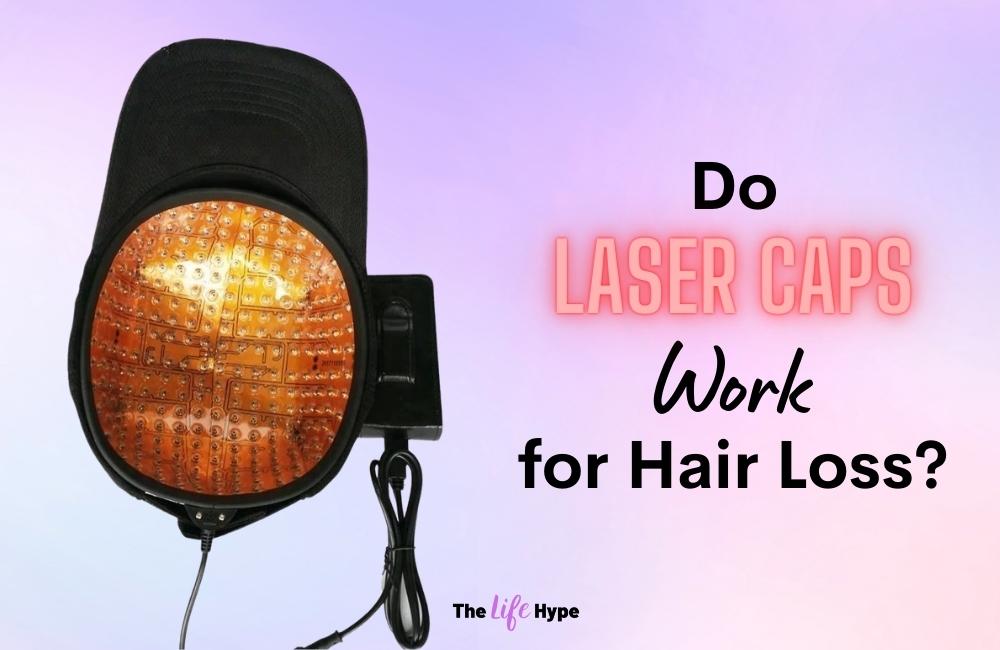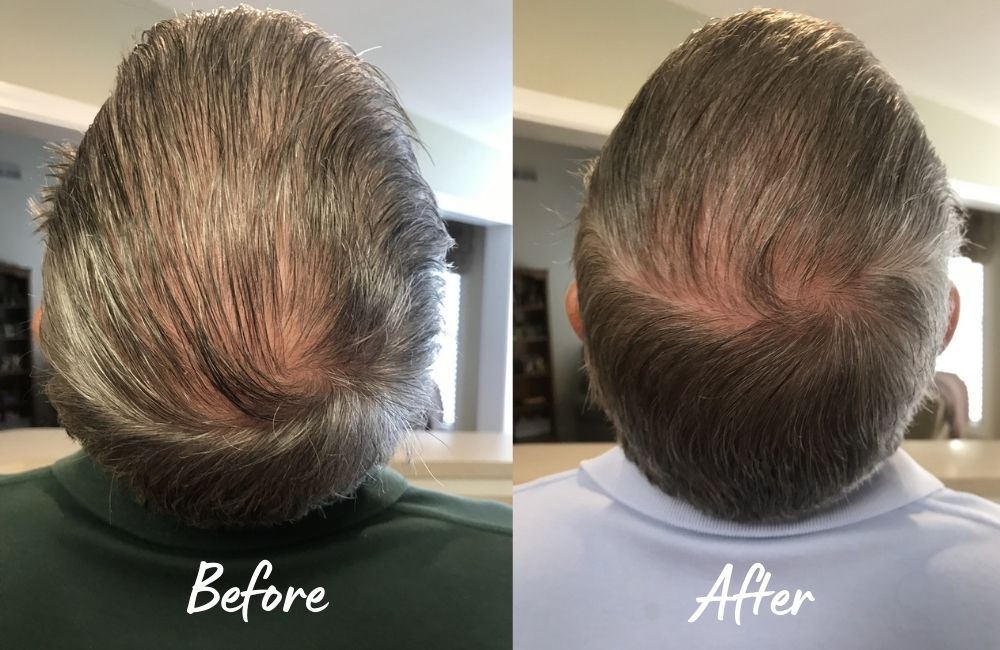If you have been experiencing hair fall, low-level laser therapy might have caught your attention and you might wonder – do laser caps work for hair loss?
We can help you determine if laser caps or helmets can benefit you if you are new to laser therapy.
Read on to learn about laser caps to regrow hair and how low-level laser therapy can treat hair loss.
Table of Contents
What is Laser Cap Therapy?
Laser caps, which use low-level laser therapy (LLLT) — aka red light therapy and cold laser therapy, are gaining a lot of attention recently.
Laser caps appear to be regular baseball caps, except they are lined with laser diodes. We recommend wearing the cap a few times a week, depending on the manufacturer.
With the cap on, the laser light penetrates the scalp at a fine-tuned intensity and wavelength. Cells in the hair follicles absorb this light, causing hair to grow. It can stimulate cells and awaken hair follicles from their resting state.
Laser hair growth devices are available as helmets, caps, laser combs, and headbands. Those who have used the therapy find the caps convenient since they are more flexible.
Laser hair caps and helmets emit low levels of light and are safe for home use.
When combined with other hair-regrowth methods, laser cap therapy can be effective – but don’t rely on it exclusively!

How Do Laser Caps Work for Hair Loss?
The laser hair growth caps stimulate the scalp and hair follicles. The caps use lower-strength lasers, which emit photons that penetrate the scalp and target the hair follicles. The light emanates in the red light or infrared range. Low-level light therapy produces photons that increase adenosine triphosphate (ATP) production in hair cells to boost hair growth.
In 2017, a study found that laser therapy can effectively treat androgenic alopecia (which affects both men and women). Further, laser caps are most effective for hair loss in the early stages.
In another study, a device similar to these caps was used on women called Handi-Dome Laser. The study showed a 51% increase in the hair growth rate of women.
Additionally, several studies have been conducted by the laser cap manufacturing industry itself.
While many laser helmets or caps on the market have FDA safety approval, FDA has not tested these products for efficacy. While we need more long-term studies, current evidence indicates that legitimate, FDA-approved laser devices offer a safe and effective method for addressing male and female pattern baldness and androgenetic alopecia.
Laser hair regrowth devices require consistency and patience. You will need to wear the laser hair cap for a couple of months before seeing any hair regrowth.
If taken several times a week, the laser caps can help hair grow faster. The hair cycle lasts every three months, and about 15% of our hair is always in a shedding mode. With regular treatment, you may prevent further loss of hair as well as increase growth.
What Happens Before and After the Treatment?

Before laser cap therapy
Wear the cap on a clean scalp that is free of buildup.
Immediately after wearing the cap, a brief period (up to 20 minutes) occurs to allow the laser to penetrate deeply.
An office procedure involves scanning a patient’s scalp under a microscope to ensure no area remains untreated.
During the treatment, the low-level laser is focused directly onto your scalp.
After laser cap therapy
Laser caps can take anywhere from 10 to 20 minutes to treat. They are safe to leave on the scalp for this long.
After completing the treatment, the cap is removed, and the remaining treatment session is repeated.
To stimulate hair growth in your scalp and see results, it may take anywhere from 5 to 7 months.
According to a 2013 study of 41 men ages 18 to 48, laser hair therapy increased the growth of hair by 39 percent over 16 weeks.
How are laser caps better than other hair loss treatments?
With laser caps, you will save money compared to other laser therapies, and you will see better results from a treatment that is both safe and effective.
Here are a few reasons why these laser hair caps stand out from other hair therapies:
- Painless and non-invasive.
- Affordable and easy to maintain.
- Slow down the loss of hair instead of stopping it with temporary treatments.
- Treatments like topical minoxidil and hair transplants have side effects, as they only work on new hair. Laser caps, on the other hand, have zero side effects.
However, there are some reasons why some people are not as happy with the procedure, including:
- Consumes a lot of time
- Can be expensive when conducted at a clinic
- Less effective for those in advanced stages of hair loss
- Long-term effectiveness has not yet been established
Does LLLT work for everyone?
Laser caps work for hair loss but the results will vary depending on the condition of your scalp and hair.
Due to inconsistent results of laser therapy, the medical community concludes that it may work for some people but not others.
Loss of hair that is not the result of medications, accidents, diseases, treatments, or genetics may be suitable for a laser cap.
In other words, if you’re in the early stages of hair thinning and loss, laser caps may be able to help you slow down the loss.
The efficacy of laser hat therapy also depends on how healthy the target cells are. Hence, it is likely that this therapy would be more beneficial when it is integrated into a holistic regimen including vitamins, minerals, and topical treatments, coupled with herbal warriors to combat internal stress or hormonal imbalance.
When your follicles receive a positive reaction, they begin to grow hair and gain the nutrients they need to thrive.
The available options for Laser hair caps
Several options are available on the market, so you can choose the one that suits your needs. Here are a few:
- Kiierr Laser Cap Complete System
- iRestore Laser Hair Growth System
- CapillusUltra Mobile Laser Therapy Cap
- iGrow Laser Hair Growth Helmet
- ReGrow MD Laser Cap 272
- Theradome PRO LH80
- SuperGro Laser Hair Growth Cap
Some of the available caps are of excellent quality, others are average, and others are of lower quality. Choose your cap accordingly.
The pros and cons of each product are clearly described in this detailed review of laser hair growth caps.
How to Choose a Laser Cap for Hair Growth
If you’re considering investing in a laser cap, make sure you invest in a quality device. Here are some things to ensure you purchase a device that targets your hair issue:
Wavelength
A wavelength of 650-900 nm at 5 mW effectively treats male and female pattern baldness. Depending on the device, wavelengths can range from 600-11000 nm, and their powers vary.
Number of diodes
The more diodes, the better the coverage. The fewer diodes, the lower the coverage. Make sure that the laser diodes are medical grade.
Quality
Buy your device from a physician’s office, a clinic, or an online shop that you can trust. Speaking with a medical professional can be extremely helpful to ensure any device you are considering is safe, clinically proven and effective.
FDA approval
FDA clearance is necessary to make sure devices are safe and effective. Thus, make sure the device you choose is FDA-cleared.
Price
A quality device comes at a price. Typically, devices cost hundreds to thousands of dollars, with recommended usage periods of six to twelve months.
Is there a brand I can trust?

When it comes to brands you can trust, I would recommend Kiierr Laser Cap.
Women and men can benefit from this laser cap by Kiierr, which stimulates healthy hair to grow while targeting hair loss and thinning.
Kiierr’s laser hair growth device is FDA-approved and uses medical-grade laser diodes that are more effective than most caps available.
This cap uses both red and infrared light to stimulate hair follicles from within, giving the appearance of thicker, healthier hair. This also permits hair follicles to open, allowing new hair shafts to grow.
One of the best things about the Kiierr hair growth system is that they offer a money-back guarantee if you don’t see results within seven months, something most other caps don’t offer.
If you just finished this treatment, you may have to wait a few more weeks before seeing the final result.
With time, your hair will grow back, and you will need fewer treatments to maintain the results.
Does laser therapy for hair loss provide a permanent result?
Even if some offer lasting results for those who start early in their hair loss, LLLT may not work for everyone in the same way.
The use of a light therapy cap has proven effective for baldness in many instances for patients diagnosed with hair follicle laser treatment and those with bald spots.
Again, depending on your degree of hair loss, you may see good results with laser therapy if you are in the early stages of losing hair.
Do laser caps for hair growth have any side effects?
After you stop using the laser hat, you may experience hair loss, or the hair may fall faster than before.
Before you undergo laser treatment, consult your doctor since certain medications may cause hair loss and may need to be taken at different doses.
Final Thoughts
Especially when hair loss is genetic, no treatment is guaranteed to work. With consistent use, laser caps and other non-surgical hair restoration treatments can stop loss of hair from progressing too quickly. Those in more advanced stages of hair loss may benefit from other treatments such as FUE hair transplant surgery.
Answering your question – do laser caps work for hair loss? They certainly do! While laser treatments are safe and effective, it is still essential to maintain an active hair care routine and lifestyle.
When you treat hair loss symptoms early, you have a better chance of preventing irreversible damage.